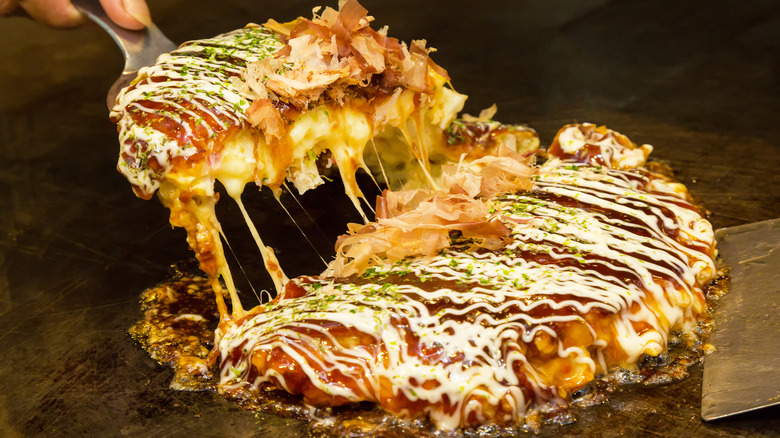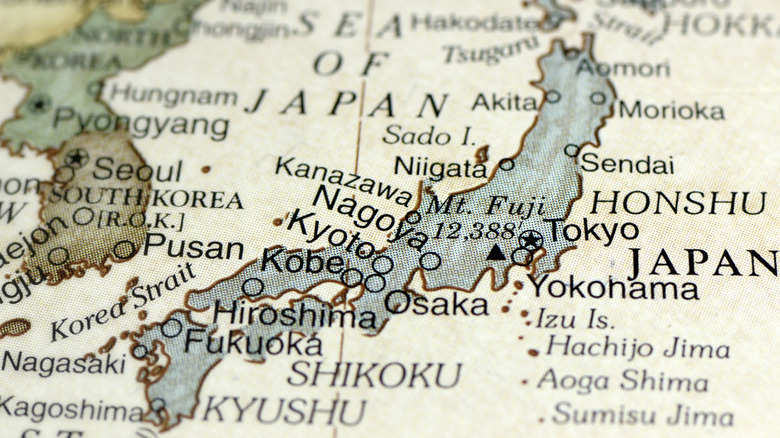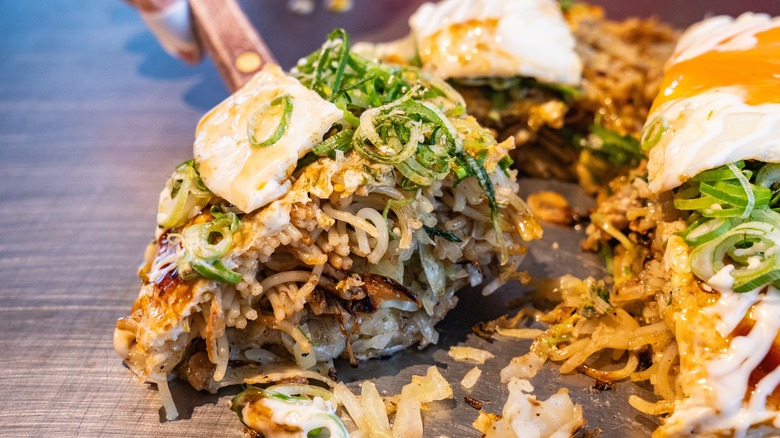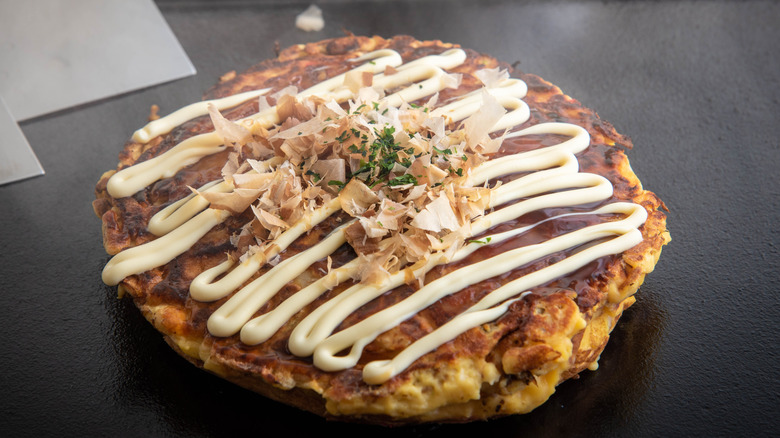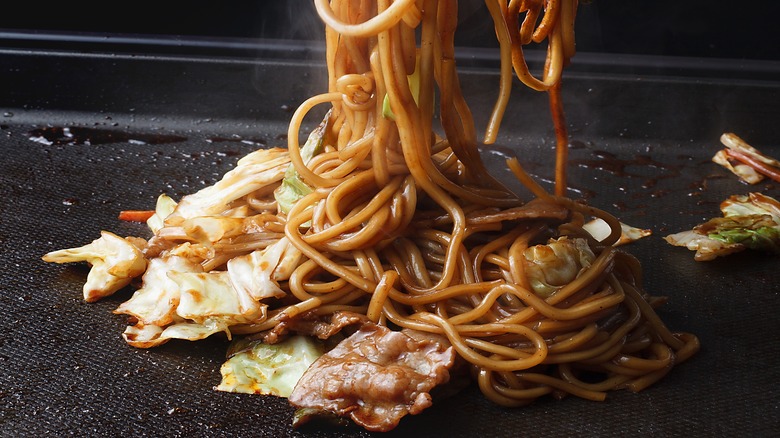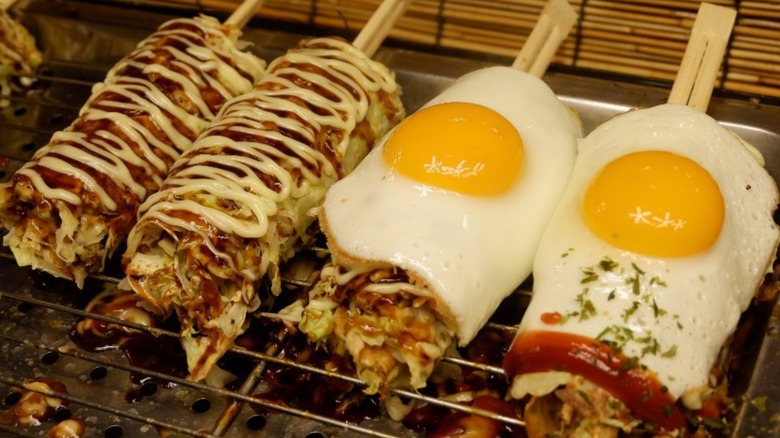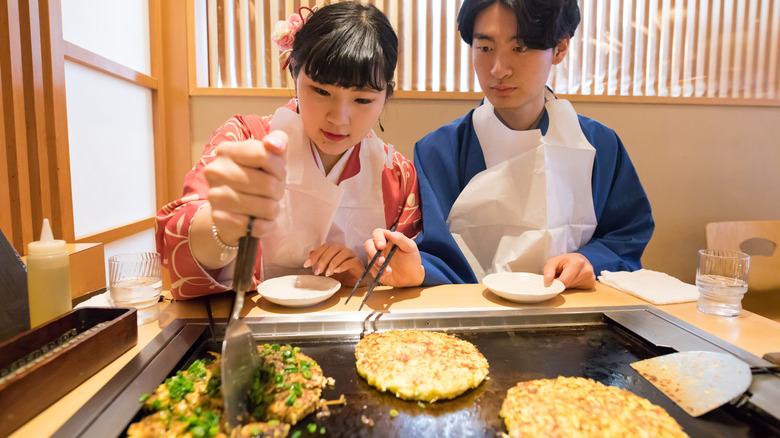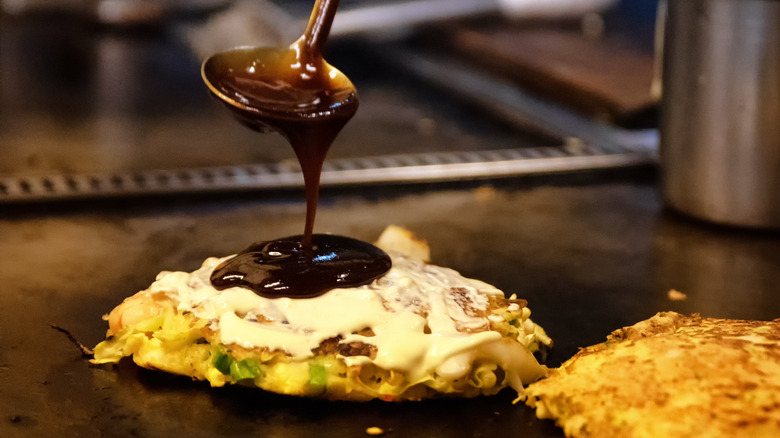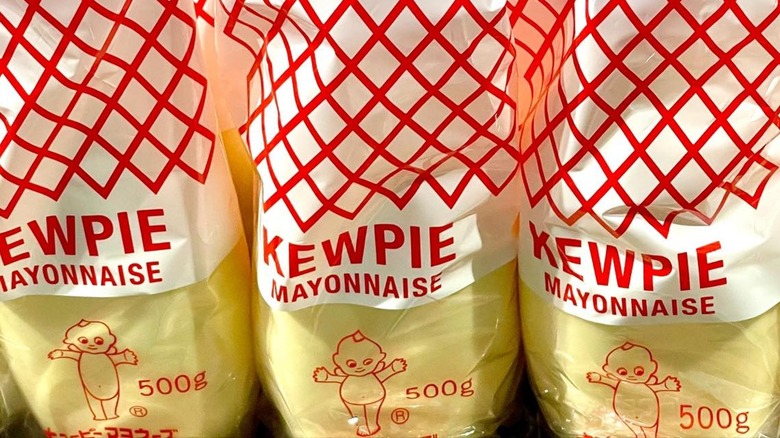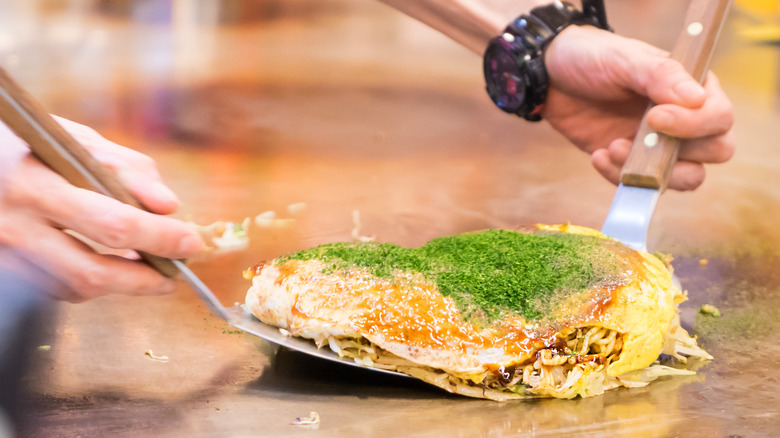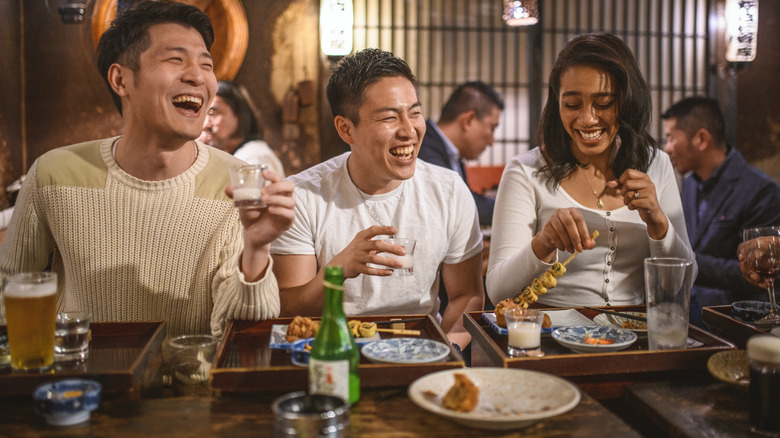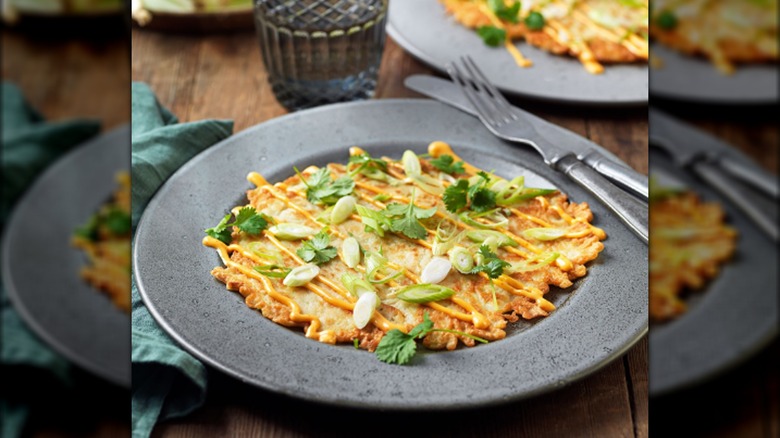What Is Okonomiyaki And How Do You Make It?
When you think about Japanese cuisine, what foods come to mind? Probably sushi, ramen, and tempura are near the top of the list. But what about okonomiyaki? Sometimes called Japanese pizza or Japanese pancakes, okonomiyaki is a little bit of both, and yet, neither at all. It is not trying to imitate Western pizza or pancakes, though it does share certain elements with both.
The word okonomiyaki literally means "whatever you want grilled," and can be topped with anything the diner desires, a quality it shares with pizza. Also, like pizza, okonomiyaki is almost exclusively a savory dish. The base is a batter made from flour and is poured, much like a pancake. It may also be made with thin, crêpe-like layers, but more on that later.
Okonomiyaki can be a delicious mess of multiple sauces and toppings, making it quite different from what Westerners may be used to in Japanese cuisine. Can it be eaten with your hands like pizza? Or a knife and fork like pancakes? Or are chopsticks the best approach? And why does a restaurant trust you to grill your own? There are so many things to cover when it comes to eating okonomiyaki for those who have never tried it. Read on to learn all about this awesome Japanese food that is not to be missed.
Disputed origins
You often hear that okonomiyaki originated in Hiroshima. Most Westerners probably know Hiroshima as the first Japanese city where the United States dropped an atomic bomb. After that devastating attack, resources were scarce, and people cobbled together meals based on what they could get their hands on. Given okoniyaki's plethora of ingredients and toppings, and its literal "as you like it" nature, it would make sense that such a dish was born out of this desperate need.
However, grilled pancake-like foods date back to at least the 17th century in Japan, though they tended to be sweet rather than savory. Indeed, a simple savory pancake that was topped with bonito (dried fish flakes) and green onions called "issen yōshoku," or Western food, existed in pre-war Hiroshima. (Yōshoku isn't Western food so much as Japanese food inspired by Western food. Few Westerners would recognize issen yōshoku as a Western dish.) While the name okonomiyaki was first used in Osaka in the 1930s to describe a grilled savory pancake that was becoming popular there, it was this cheap snack enjoyed by many, and bolstered by the influx of wheat flour brought to post-war Japan as aid from the U.S, that evolved into the beloved okonomiyaki of today.
Hiroshima style
Hiroshima is the name of both a prefecture as well as that prefecture's capital city. Although nearly flattened after World War II, today's Hiroshima is a vibrant, modern city that loves to eat! It is the home of Okonomimura (meaning Okonomi Village), which can be found right downtown. The 25-plus okonomiyaki restaurants found there each have their own distinct style and are totally worth exploring if you find yourself in the area. This isn't the only place to find this signature dish, however. Over 2,000 restaurants in Hiroshima serve okonomiyaki.
One of the things that makes Hiroshima style distinct is its separate layers. Rather than a thick layer of batter, like a pancake, the batter is ladled to be thin and more like a crêpe. This is then followed by a layer of cabbage, bean sprouts, and whatever else one desires. Next comes the other thing that makes Hiroshima style unique: noodles. Udon and yakisoba are popular choices, but really any noodle will do. Another layer of batter is ladled on, and the entire thing is carefully flipped. All of this is topped off with a fried egg and a sauce that is slightly sweeter than other okonomiyaki varieties. Each layer offers not only a variety of flavors, but also textures.
Kansai style
Kansai is one of the names for a region on the western side of Japan's largest island Honshu. It includes ancient Japanese capitals like Nara and Kyoto, Kobe (famous for its beef), as well as Japan's third largest city, Osaka. Because of this, Kansai style okonomiyaki is also commonly called Osaka style.
What makes Kansai's okonomiyaki unique is that the shredded cabbage and other inclusions of choice are mixed into the batter before pouring it onto the griddle, resulting in a thicker pancake. If meat is being used, it is often placed onto the batter after it has started to cook. Kansai okonomiyaki is flipped halfway through to ensure that it is cooked through on both sides. To top it all off, Japanese mayonnaise and okonomiyaki sauce are liberally drizzled on followed by bonito flakes and seaweed powder. The sauce used in Kansai is less sweet and has more of a tang than okonomiyaki sauce from other regions like Hiroshima and Tokyo. The outside of the pancake is almost crispy, while the inside is fluffy.
To noodle or not to noodle
As we already covered, one of the things that sets Hiroshima okonomiyaki apart from Kansai style is the inclusion of noodles. There are a lot of options for noodles in Japan such as ramen, soba, and udon. Yakisoba, or grilled soba noodles, is an easy pairing since both okonomiyaki and yakisoba are cooked on a griddle or fried in a pan. (Yaki means "grilled" in Japanese.) Both ramen and soba are thinner noodles, kind of like spaghetti, while udon is thicker and offers a unique texture in okonomiyaki.
But there is another variation of the Hiroshima style that uses rice instead of noodles called shobarayaki. And instead of the usual sweet sauce, it uses ponzu sauce. One of the main ingredients in ponzu sauce is citrus juice, so it lends the okonomiyaki a pleasant tangy flavor.
Of course, Kansai okonomiyaki is not made with noodles or rice making its texture quite different from these two styles. Incorporating noodles or rice makes the dish more substantial and filling, so while all varieties of okonomiyaki are worth trying, whether or not to include either of these carbs is up to the diner.
Okonomiyaki on chopsticks
You wouldn't think that such a saucy pancake would make good street food. While it is easy to grill up just about anywhere, eating on the go is a little harder. But where there's a will, there's a way.
Hashimaki is essentially a flat okonomiyaki wrapped around a pair of chopsticks. (Hashi is Japanese for "chopsticks" and maki means "roll.") Another name for this dish is dondonyaki. The thin batter is poured onto a hot griddle. Once the bottom is done cooking, the pancake is flipped to cook the other side. When it is cooked through, one side is pinched between two disposable wooden chopsticks, then the whole thing is wrapped up around them, making this the perfect portable okonomiyaki.
You often find hashimaki at festivals, though it is not as common in eastern Japan. The toppings are similar to other varieties of okonomiyaki — fried eggs, yakisoba, and even cheese! And, of course, you can't forget the sauce and mayonnaise.
Cooking the perfect okonomiyaki
Japan is considerably more lax than the U.S. when it comes to permitting restaurant diners to cook their own food. Many okonomiyaki restaurants allow customers to grill their food at their table. The flat griddle is set into the tabletop, and it's a great way to keep the food warm while you eat. So, it's important to know what you are doing not only to have your okonomiyaki truly as you want it, but to keep from burning yourself on the grill. Of course, you'll need to know the tips and tricks if you want to make it yourself at home.
If you have never tried okonomiyaki before, it's best to have an experienced chef make it for you. But once you have decided to take on the challenge, you want to be sure that your cooking surface is preheated so that the batter holds its round shape and doesn't run all over the place. You also want to avoid flipping too soon. Eight to 10 minutes should be a long enough wait for the bottom to cook before being moved.
Once you have your okonomiyaki cooked to your liking, cut it into pieces with a metal spatula, just as you would with a pizza. You can eat using the spatula, taking slices right from the grill. But if that leaves you feeling leary, transfer the slices onto a plate and use chopsticks. Forks are also acceptable for those who need them.
All about that sauce
We have already mentioned a few different sauces from sweet to savory to citrusy ponzu (which is by no means exclusive to okonomiyaki). However, actual okonomi sauce, also called okonomiyaki sauce, is a thing of beauty.
Although it is descended from the English Worcestershire sauce, introduced to Japan during the 19th century, okonomi sauce is thicker and not as salty in flavor. It also has a sweeter taste from the inclusion of fruits, such as dates and raisins. The blend of umami, sweet, and salty goes perfectly with the mix of ingredients that make up okonomiyaki. It's also delicious with other dishes like takoyaki (fried octopus dough balls) and even hamburgers.
Okonomi sauce is available commercially, but many restaurants prefer to make their signature blend. There are also regional differences. Hiroshima and Tokyo sauces tend to be sweeter than Kansai's, for example. If you want to make okonomi sauce at home to suit your own tastes, cookbooks as well as online sources offer plenty of recipes.
Why Japanese mayonnaise is used
You might think that any mayo will do. This is not true. You want Japanese mayo, most easily obtained by reaching for a bottle of Kewpie, though you could also make it yourself if you feel ambitious. Toichiro Nakashima discovered mayonnaise while visiting the U.S. and U.K. in the 1920s. Upon returning to his home country, Nakashima created his own mayo and introduced it to the public as Kewpie Mayonnaise in 1925. A century later, Kewpie remains the most popular mayo brand in the Japanese market.
The main difference between Japanese and American mayo is that Japanese mayo uses only egg yolks, while its American counterpart uses the whole egg. This gives Japanese mayo a distinctive golden tinge. It also uses sweeter vinegars, such as apple cider, red wine, and rice vinegars, and it includes MSG, which gives it a more powerful and flavorful punch than American mayos. Nutritionally speaking, Japanese mayo has almost zero carbs and sugar and is fairly low in sodium, so you don't have to feel too bad slathering it on everything, which you will likely want to do after giving it a taste.
Okonomiyaki is an entire meal
Oftentimes, a Japanese meal is made up of different dishes. For example, soup, salad, edamame, noodles, and vegetables. Maybe some meat like tonkatsu or yakitori. Okonomiyaki, however, is a meal all on its own. There are so many ingredients and calories that go along with them, that even one whole pancake might be more than enough to fill you up, especially if you order the noodle-filled Hiroshima style or shobarayaki with rice. Expect to consume anywhere between 400 and 600 calories per whole okonomiyaki.
Luckily, just like with pizza, okonomiyaki is an easy dish to share with friends where you can divide up slices between different plates. Also like pizza, you could serve a green salad or some other light dish on the side. Including Japanese elements, such as using a ginger and miso dressing and sliced daikon on a bed of fresh greens, would be ideal. If you are watching calories, you should probably order fewer add-ons and opt for the noodleless Kansai version over Hiroshima style.
Best drinks to have with okonomiyaki
Few things on this Earth go better together than hot-off-the-grill okonomiyaki and a cold beer. We recommend Asahi Super Dry, but any Japanese beer will do. However, we do understand that not everyone is keen on beer, so we offer some alternative beverages that pair just as well.
Of course, sake is a popular and uniquely Japanese alcohol if you are still looking to get a little tipsy. With its mild flavor, sake pairs well with just about any Japanese food, and it's common to share a bottle with friends and coworkers while out on the town. Sake is also a tad on the acidic and bitter side, which contrasts with the sweetness of okonomi sauce.
If wine is more your speed, Japanese Koshu wine is said to pair quite nicely with okonomiyaki. Oko-Wine, a table wine blended specifically to go with okonomiyaki, hit the market in 2014, though it may be harder to track down today than Koshu or a dry Riesling.
Okonomiyaki outside of Japan
If your mouth is watering, but Japan is just a little too out of reach, we have good news. Although it isn't nearly as popular as sushi and ramen outside of Japan, okonomiyaki is available all across the globe. You just have to look for it.
It can sometimes be found on the menus of Japanese restaurants in the U.S., though there are significantly fewer "whatever you want" options. California seems to have the highest number of restaurants serving okonomiyaki by far, though New York and Hawaii have a fair number as well. In Canada, Vancouver and Toronto are your best bets, and in Australia, try Sydney and Melbourne. These are by no means your only options, and you definitely want to check restaurants near you. Making okonomiyaki at home is also an option. If pulling together all the correct ingredients is too difficult, Otafuku Foods makes a variety of kits that can be purchased online. They contain kelp-seasoned okonomiyaki flour, okonomi sauce, and more depending on the exact kit.
